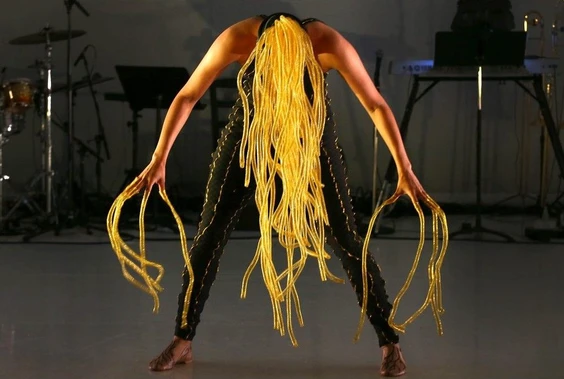Review: The brain versus the body: DJD’s show Nervous Systems seeks to understand the human condition
Coming off their tremendous success last season with Family of Jazz – which is now set to tour this coming August at Jacob’s Pillow Dance Festival – Decidedly Jazz Danceworks moved into a completely different direction, if not a new dimension, with its whimsical neural homage Nervous Systems, an 11-dancer, five-musician tour led by composer Carston Rubeling and choreographer Kimberley Cooper.
Part humoresque, part satirical sendup and, in other panels, suffused with a healthy dash of angsty commentary about what our brains tell us that at times can seem to define each of our realities, Nervous Systems is unsparing in its view that we are as much beautiful inhabitants of intelligent movement machines as we are at times victims of how our neural machines can work to over-ride our rational consciousness.
It would be a mistake to think that this show was about any kind of neuropsychological perspective or a whirlwind tour of neuroscience itself. It is often said that when students begin coursework in these areas of study, proclaiming they want to study the “brain,” what they really mean is that they would prefer to study the mind. The conflation of mind and brain was broadly evidenced in the performance I took in on Wednesday night, but instead of it becoming a conceptual confusion, the show took shape as something much more interesting.
Rather than floating impressionistic ideas on nerve cells, axons and dendrites, Nervous Systems explored popular tropes about brains and nerves and succeeded more in telling us how we view the nuanced mysteries of the body system responsible for how we conceive ourselves. In other words, DJD imaginatively created a show following a famous saying: when we study the brain, the brain seeks to understand itself.

For example, most of Part One: Inside was devoted to something more basic and visceral. While far from a neuroanatomy lesson, the full company’s prone pulse-and-flutter presented confined choreographic movements depicting basic electrical transductions, with little opportunity for extended leg work amid confined movement space. Interspersed with whimsy and spoken word, dancers took turns at the microphone to present aphoristic but imaginative sendups of what sounded like a badly written neuropsychology textbook (“Heartache or Headache”, “Adventures in the Circulatory System”).
DJD wisely resisted supplying projected nervous system drawings and in Part One opted for costuming the company in gold-green unitards creased with black line drawings of nerve fibres running from shoulder to ankle like abstracted descending fibre tract traces – a nice and inexpensive touch.
Perhaps the best panel of Part One was “Touching, Isn’t She” featuring Cassandra Bowerman who would feign slowly left then right with a deceptively gentle gesture one moment, and then a violent shove the next, showing how the full range of touch upon skin cells can come alive. With all the dancers at one point rising above the floor, squirming wormlike, stretching like hair follicles when sensory stimulated, it was a routine but effectively controlled demonstration of how versatile our skin can be whether we experience the merest of passing sensory pressures, or when we absorb physical assault.
In other sections, sometimes a small ensemble would form a beating heart, and in others, the company would flash from seeming chaos to a confluence of neural energies (“Fight of Flight”), shooting in multiple directions down axons to pathways unseen.
Part Two: Out wrestled more with our illusions about the nervous system through pop cultural movies such as the 1967 classic Fantastic Voyage, which in DJD’s hard-edged dreamscape version (“Rapid Eye Movement” featuring a remarkable Catherine Hayward), satirizes an astronaut being shrunk to onstage doll size where he takes an inner journey to the microscopic neural world and is promptly eaten by antibodies to the amusement of most of the audience.
“Rapid Eye Movement” comprises a pop cultural breeze-through using earlier sci-fi lore such as the “brain-eating monster (“Braineater” – gleefully danced by an orange tendrilled Sabrina Naz Comănescu), forming a bad dream triptych. A random-walking astronaut, what looked like a giant, Nissl-stained motor neuron with Natasha Korney trapped in fabric forming an exceptionally lithe nucleus, and a stream-of-consciousness series of suppressed ideas allowed to groove forth during REM sleep, added to the eclectic circus of disconnected images. Of course, everyone will take away something different from this triptych but it isn’t hard to view it as a microcosm within the microcosm. If neurons do the dreaming for us, then what would do the dreaming for the neurons?
The highlight of the night was undoubtedly Kaja Irwin’s unimaginably sublime “You’ve Got Some Nerve.” Three large black balloons, with their strings tied to her pink frilled top, phantomed floating torso lifts one moment and anti-gravity crushing movements the next – a deep tribute to ecstasy and elation and how it can be just as quickly obliterated by depression and darkness. For all the show’s angular apposed lines of dance and sound, “Nervous System” could be a performance of disturbing opposites of the human condition examined inside the human body – graceful one moment, but disturbing the next.
Nervous Systems runs at DJD Dance Centre until May 14.
https://calgaryherald.com/entertainment/local-arts/the-brain-versus-the-body-djds-show-nervous-systems-seeks-to-understand-the-human-condition